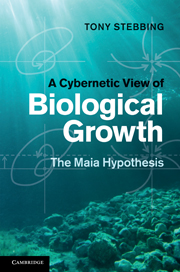Book contents
- Frontmatter
- Contents
- Foreword by Ernest Naylor
- Preface: ‘A fragment of a possible world’
- Acknowledgements
- 1 Introduction
- 2 Growth unlimited: blooms, swarms and plagues
- 3 Self-regulating systems: from machines to humans
- 4 The wealth of homeodynamic responses
- 5 A cybernetic approach to growth analysis
- 6 A control mechanism for Maia
- 7 The three levels of adaptation
- 8 Population growth and its control
- 9 Hierarchy: a controlled harmony
- 10 History of hormesis and links to homeopathy
- 11 Maian mechanisms for hormesis and catch-up growth
- 12 Cellular growth control and cancer
- 13 Human overpopulation
- 14 Our finite Earth
- 15 The Maia hypothesis and anagenesis
- Glossary
- Further reading
- References
- Index
8 - Population growth and its control
Published online by Cambridge University Press: 10 January 2011
- Frontmatter
- Contents
- Foreword by Ernest Naylor
- Preface: ‘A fragment of a possible world’
- Acknowledgements
- 1 Introduction
- 2 Growth unlimited: blooms, swarms and plagues
- 3 Self-regulating systems: from machines to humans
- 4 The wealth of homeodynamic responses
- 5 A cybernetic approach to growth analysis
- 6 A control mechanism for Maia
- 7 The three levels of adaptation
- 8 Population growth and its control
- 9 Hierarchy: a controlled harmony
- 10 History of hormesis and links to homeopathy
- 11 Maian mechanisms for hormesis and catch-up growth
- 12 Cellular growth control and cancer
- 13 Human overpopulation
- 14 Our finite Earth
- 15 The Maia hypothesis and anagenesis
- Glossary
- Further reading
- References
- Index
Summary
Population, when unchecked, increases in exponential ratio.
T.R. MalthusNobody foresaw how the apparently simple Logistic Map would yield this graphic beauty.
Robert MayA RATIONALE FOR SELF-LIMITING POPULATION GROWTH
The simplest, and probably the earliest, way in which population growth was regulated is by the limitation of raw materials necessary for further growth. In Chapter 1, the blooming of huge populations of the single-celled alga Emiliania huxleyi was used to illustrate the exponential growth of populations. Each year in the ocean, Emiliania numbers grow rapidly following the peak in diatom numbers. Blooms appear, preferring the lower concentrations of phosphates and the high light intensities found in mid-summer. The growth of other microalgae is similar, in being limited by the availability of the essentials for life: space, nutrients, trace elements, vitamins and so on. When any essential nutrient becomes less than optimal, the growth rate slows and populations decline.
Such a cycle of events is inevitable for those organisms that synthesise their own organic matter from inorganic sources. Plants and algae in the sea are autotrophs and manufacture what they need from recycled nutrients, carbon dioxide and water, with energy from the sun. When the resources essential for their growth are available, and conditions are optimal, densities grow to millions of cells per litre, and blooms cover vast areas of the world's oceans (Figure 2.1b). Their exponential growth rapidly strips the surface waters of available nutrients, which ultimately causes a decline in numbers as rapid as their appearance.
- Type
- Chapter
- Information
- A Cybernetic View of Biological GrowthThe Maia Hypothesis, pp. 170 - 203Publisher: Cambridge University PressPrint publication year: 2010

